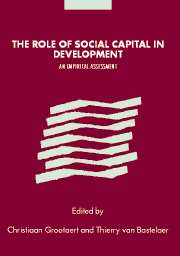Book contents
- Frontmatter
- Contents
- List of figures and maps
- List of tables
- List of boxes
- Notes on contributors
- Acknowledgments
- Foreword by Robert D. Putnam
- Introduction and overview
- Part 1 Social capital at the micro and macro levels: a conceptual discussion and review
- Part 2 The impact of social capital on development
- 3 Mapping and measuring social capital through assessment of collective action to conserve and develop watersheds in Rajasthan, India
- 4 Social capital and the firm: evidence from agricultural traders in Madagascar
- 5 How do participation and social capital affect community-based water projects? Evidence from Central Java, Indonesia
- 6 Does social capital increase participation in voluntary solid waste management? Evidence from Dhaka, Bangladesh
- Part 3 The creation and transformation of social capital
- Conclusion: measuring impact and drawing policy implications
- Index
- References
4 - Social capital and the firm: evidence from agricultural traders in Madagascar
Published online by Cambridge University Press: 22 September 2009
- Frontmatter
- Contents
- List of figures and maps
- List of tables
- List of boxes
- Notes on contributors
- Acknowledgments
- Foreword by Robert D. Putnam
- Introduction and overview
- Part 1 Social capital at the micro and macro levels: a conceptual discussion and review
- Part 2 The impact of social capital on development
- 3 Mapping and measuring social capital through assessment of collective action to conserve and develop watersheds in Rajasthan, India
- 4 Social capital and the firm: evidence from agricultural traders in Madagascar
- 5 How do participation and social capital affect community-based water projects? Evidence from Central Java, Indonesia
- 6 Does social capital increase participation in voluntary solid waste management? Evidence from Dhaka, Bangladesh
- Part 3 The creation and transformation of social capital
- Conclusion: measuring impact and drawing policy implications
- Index
- References
Summary
Economists typically use physical capital and labor as inputs in the description of production processes as it is believed that these inputs are essential to production. The same reasoning could be applied to other inputs. In particular, anybody involved in purchases and sales activities knows that contacts and relationships are also essential inputs for a firm's survival. However, while the importance of this “social” capital has long been recognized in other social sciences (see, for example, Granovetter 1985, 1995; Coleman 1988; Putnam 1993; Helliwell and Putnam 1995), this view has only recently received attention in the economics literature (Narayan and Pritchett 1997; Barr 1998; Fafchamps 1998; Fafchamps and Lund 1998; Grootaert 1999).
The definition of social capital in different economic and social studies has not been uniform. Some researchers have defined it in terms of trust and norms of civic cooperation (Knack and Keefer 1997; Temple and Johnson 1998) or in terms of cultural values, such as degrees of compassion, altruism, and tolerance (Fukuyama 1995). Others have emphasized institutions and the quality and quantity of “associational” life (Coleman 1988; Putnam 1993; Narayan and Pritchett 1997; Grootaert 1999). While those definitions share common elements, their exact meaning is imprecise and thus difficult to measure. The vagueness of the concept may be one reason why economists have been wary of using it.
Social capital in its broadest sense can influence economic exchange in two ways.
- Type
- Chapter
- Information
- The Role of Social Capital in DevelopmentAn Empirical Assessment, pp. 125 - 154Publisher: Cambridge University PressPrint publication year: 2002
References
- 10
- Cited by

